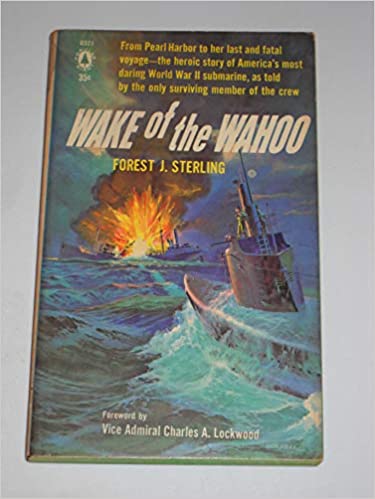I really like memoirs and biographies. There are three that I just finished. I would recommend two of them as really good reads.
The Yeoman
Wake of The Wahoo by Forest J. Serling is a submarine memoir, something that I am a real sucker for. It differs from most submarine memoirs in that Sterling was an enlisted man. As a yeoman, though, he worked closely with the officers and has some very nice words for Richard O’Kane, Wahoo’s exec who would later be awarded the medal of honor as skipper of the Tang. Sterling was an old salt with a break in service having served two enlistments in the thirties reenlisting when the war broke out. His hard scrabble depression background is an interesting contrast to the officer memoirs, which were written by pretty much straight arrow Annapolis graduates.
As yeoman, Sterling was something of a link between the officers and the men. He also probably had a better sense of the big picture in that he was the one who typed the patrol reports. During his first patrol, he didn’t have much to do during attacks, but in subsequent ones he was in the middle of things taking notes in real time.
The other sailors sometimes gave him a hard time about being too close to the officers. Kiddingly defending himself, he indicated that he always got the last words in when speaking with O’Kane – “Yes sir”.
Contrasting this with the officer memoirs, it seems that at least in terms of really being off, liberty was better for enlisted men. There is a pretty good account of a week with a naval widow in Brisbane.
(Spoiler Alert)
Sterling had applied for stenography training, but Mush Morton asked him to go on one more patrol. Just before departing, Morton took him to the Squadron Commander and said to the commander that Sterling was a great yeoman and he had orders to Stenography School, could he have a relief?
That set up the haunting ending to the memoir.
“I threw my sea bag on the rough planks and sat down on it. I lighted several cigarettes and smoked them before Wahoo, a tiny submarine silhouette on the horizon, headed into in a rain squall and disappeared from sight. Forever.”
Subsequent reconstructions from Japanese sources indicate that Wahoo’s seventh war patrol accounted for the sinking of four merchant ships. Wahoo is, as they say, still on patrol – declared overdue on 2 December 1943
The Naval Airman
The Miraculous Torpedo Squadron is also a great read. It relates an event which was the critical link in the transition in Herman Wouk’s fictional Winds of War and War and Remembrance. Victor “Pug” Henry’s ambition and dream was to command a battleship, but when he finally gets his wish, his battleship, California, is sunk at Pearl Harbor before he can take command.
Pug ends up with command of the Cruiser Northhampton.
The author of The Miraculous Torpedo Squadron tells the story of the sinking of the California.
“Buildings and other structures on the wharf made it hard for me to get down low, but I eventually cleared the obstacles and dropped down to about fifteen feet over the water. I got the plane completely trimmed and horizontal. At a speed of 130 kits (?) I closed to within 250 yards of California, held my breath and aimed just below and to the right of the ships bridge.”
I do have to say that my bs detector was just a little bit on the alert as I read Juzo Mori’s account of exploits as an enlisted naval pilot in the Imperial Japanese Navy. In the introduction it is indicated that Mori ran a bar called the Cart Driver (slang for torpedo plane pilot) and there is a reason for the expression “war stories”. The other thing about the book that is a bit jarring is that the translator chose to use an informal colloquial style in the translation. An illustration of this is in one of the most fascinating passage as Mori describes the scene in Tokyo after his carrier Soryu returns from operations in the Indian Ocean.
“We were surprised to see that many of the windows in the houses near the harbor were broken. When we asked what had happened we were told that enemy bombers had attacked Tokyo.”
“The newspapers were filled with stories about the sub-human American devils and other hyperbole, but those were just excuses. The reality was that they had come in the front door, kicked our butts and got away without a scratch. Unbelievable!”
In some ways though it seems like the translator made a good choice. Mori, even though an experienced pilot, was an enlisted man and it is reasonable to think that he must have sounded a bit salty.
The story takes us through Mori’s brutal training through operations over China, Pearl Harbor, Midway, where Soryu sinks and operations over Guadalcanal where Mori was stranded on short rations from a while. Wounds on Guadalcanal disabled him as a pilot.
It really was interesting reading a memoir of those actions from the other side. I really recommend this one.
The third memoir is actually not a very good read but it has a lot of very interesting information in it, so I think that Colonel Retread by Carlton Ketchum rates its own post, which I will try to get to soon.































































































